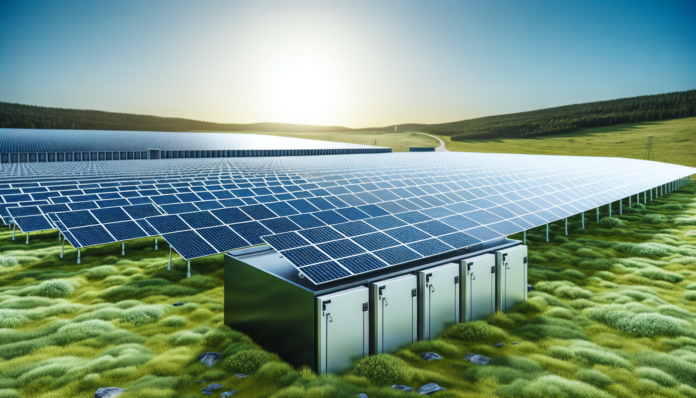Introduction
Overview of Solar Energy
Solar energy has emerged as a cornerstone of the global shift towards renewable energy. Harnessing the power of the sun, solar energy systems convert sunlight into electricity using photovoltaic (PV) cells. Over the past few decades, advancements in solar technology have significantly increased the efficiency and affordability of solar panels, making solar energy a viable option for both residential and commercial use. The widespread adoption of solar energy is driven by its potential to reduce greenhouse gas emissions, decrease reliance on fossil fuels, and provide a sustainable energy source for future generations.
Importance of Energy Storage
While solar energy offers numerous benefits, its intermittent nature poses a significant challenge. Solar panels generate electricity only when the sun is shining, leading to periods of surplus energy during the day and a lack of energy at night or during cloudy weather. This mismatch between energy production and demand necessitates effective energy storage solutions. Energy storage systems (ESS) act as a bridge, capturing excess energy generated during peak sunlight hours and releasing it when needed. This capability not only ensures a stable and reliable power supply but also enhances the overall efficiency and integration of solar energy into the grid.
Energy storage technologies are diverse, ranging from traditional batteries to advanced solutions like supercapacitors, thermal storage, and hydrogen storage. These systems play a crucial role in balancing supply and demand, stabilizing the grid, and enabling the seamless integration of renewable energy sources. As the world moves towards a more sustainable energy future, the development and deployment of advanced energy storage solutions are becoming increasingly important.
Purpose of the Article
The purpose of this article is to explore the transformative impact of emerging solar energy storage solutions on the energy landscape. By examining the current state of solar energy storage, recent technological advancements, and the benefits of advanced storage systems, we aim to provide a comprehensive understanding of how these innovations are changing the game. The article will also delve into various applications and use cases, highlighting the practical implications of advanced energy storage solutions in residential, off-grid, and emergency scenarios.
Furthermore, we will address the challenges and considerations associated with the adoption of these technologies, including cost, technical barriers, regulatory issues, and maintenance. By providing a balanced perspective, this article seeks to inform and inspire stakeholders, policymakers, and consumers to embrace and support the development of advanced solar energy storage solutions. Ultimately, our goal is to underscore the critical role of energy storage in achieving a sustainable and resilient energy future.
The Current State of Solar Energy Storage
Traditional Storage Solutions
Solar energy storage has traditionally relied on several key methods, each with its own set of advantages and limitations. The most common storage solutions include:
- Batteries: The most prevalent form of energy storage, especially in residential settings. Lead-acid and lithium-ion batteries are the most widely used types. Lead-acid batteries are cost-effective but have shorter lifespans and require more maintenance. Lithium-ion batteries, on the other hand, offer higher energy density and longer lifespans but come at a higher cost.
- Thermal Storage: This method involves capturing heat from the sun, which can be stored and used later for heating or to generate electricity. Molten salt is a common medium for thermal storage, known for its high heat retention and ability to store energy for extended periods.
- Mechanical Storage: Technologies like pumped hydro storage, flywheels, and compressed air storage fall under this category. Pumped hydro is the most mature and widely used, involving the pumping of water to a higher elevation and releasing it to generate electricity when needed.
Limitations and Challenges
While traditional storage solutions have been effective to some extent, they come with several limitations and challenges:
- Cost: High initial investment costs, especially for advanced battery technologies like lithium-ion, can be a significant barrier to widespread adoption.
- Efficiency: Energy losses during storage and retrieval can reduce the overall efficiency of the system. For example, lead-acid batteries have lower efficiency compared to lithium-ion batteries.
- Longevity: The lifespan of storage solutions varies, with lead-acid batteries requiring frequent replacements, adding to long-term costs.
- Environmental Impact: The production and disposal of batteries, particularly those containing heavy metals, pose environmental challenges.
- Scalability: Mechanical storage solutions like pumped hydro are not easily scalable and are highly dependent on geographical factors.
Recent Advances in Technology
Recent technological advancements are addressing many of the limitations associated with traditional storage solutions, paving the way for more efficient and sustainable solar energy storage:
- Next-Generation Batteries: Innovations in battery technology, such as solid-state batteries and sodium-ion batteries, promise higher energy densities, longer lifespans, and improved safety. These advancements are making batteries more cost-effective and environmentally friendly.
- Supercapacitors: These devices store energy through electrostatic fields rather than chemical reactions, allowing for rapid charging and discharging. While they currently have lower energy densities compared to batteries, ongoing research aims to enhance their storage capacity.
- Thermal Storage Innovations: New materials and methods, such as phase-change materials and advanced molten salts, are improving the efficiency and storage capacity of thermal systems. These innovations make thermal storage more viable for both residential and large-scale applications.
- Hydrogen Storage: Hydrogen can be produced using excess solar energy through electrolysis and stored for later use. This method offers a high energy density and can be used in fuel cells to generate electricity, providing a versatile and scalable storage solution.
In summary, while traditional solar energy storage solutions have laid the groundwork, recent technological advancements are significantly enhancing the efficiency, scalability, and environmental sustainability of solar energy storage. These innovations are crucial for overcoming the limitations of traditional methods and are set to play a pivotal role in the future of renewable energy.
Emerging Solar Energy Storage Solutions
Next-eneration Batteries
Next-generation batteries are at the forefront of solar energy storage innovation. Traditional lithium-ion batteries have been the mainstay for years, but new advancements are pushing the boundaries of what is possible. **Solid-state batteries** are one such innovation, offering higher energy densities and improved safety by replacing the liquid electrolyte with a solid one. This change reduces the risk of leaks and fires, making them a more reliable option for both residential and commercial applications.
Another promising development is **sodium-ion batteries**. Unlike lithium, sodium is abundant and inexpensive, which could significantly lower the cost of energy storage. These batteries also have the potential to operate efficiently at lower temperatures, making them suitable for a wider range of environments.
**Flow batteries** are also gaining traction, particularly for large-scale energy storage. These batteries store energy in liquid electrolytes contained in external tanks, allowing for easy scalability. The ability to increase storage capacity simply by adding more electrolyte makes flow batteries an attractive option for grid-scale applications.
Supercapacitors
Supercapacitors, also known as ultracapacitors, are another emerging technology in solar energy storage. Unlike traditional batteries, which store energy through chemical reactions, supercapacitors store energy electrostatically. This allows them to charge and discharge much faster than conventional batteries, making them ideal for applications requiring rapid bursts of energy.
One of the key advantages of supercapacitors is their long lifespan. They can endure millions of charge and discharge cycles without significant degradation, which makes them highly reliable. Additionally, supercapacitors are less affected by temperature variations, enhancing their performance in diverse climatic conditions.
However, supercapacitors currently have a lower energy density compared to batteries, which means they can’t store as much energy in the same amount of space. Researchers are actively working on improving this aspect, with innovations in materials science promising to bridge the gap.
Thermal Storage
Thermal storage is a method that captures and stores solar energy in the form of heat. This stored heat can then be used to generate electricity or provide heating when needed. **Molten salt** is a popular medium for thermal storage due to its high heat retention capabilities. In concentrated solar power (CSP) plants, molten salt can store heat for several hours, allowing for electricity generation even after the sun has set.
Another approach to thermal storage involves **phase change materials (PCMs)**. These materials absorb and release heat during phase transitions, such as from solid to liquid. PCMs can store large amounts of energy in a relatively small volume, making them suitable for both residential and industrial applications.
Thermal storage systems are particularly beneficial for grid stability. By storing excess solar energy during the day and releasing it during peak demand periods, they help balance supply and demand, reducing the strain on the grid.
Hydrogen Storage
Hydrogen storage represents a versatile and scalable solution for solar energy storage. The process involves using solar power to electrolyze water, splitting it into hydrogen and oxygen. The hydrogen can then be stored and later used in fuel cells to generate electricity or as a direct fuel source.
One of the main advantages of hydrogen storage is its high energy density. Hydrogen can store more energy per unit weight than traditional batteries, making it an excellent option for large-scale energy storage and transportation applications. Additionally, hydrogen can be stored for long periods without significant losses, providing a reliable backup energy source.
Hydrogen storage also offers environmental benefits. When used in fuel cells, hydrogen produces only water as a byproduct, making it a clean and sustainable energy source. Advances in electrolyzer technology and the development of more efficient fuel cells are making hydrogen storage increasingly viable and cost-effective.
In conclusion, emerging solar energy storage solutions like next-generation batteries, supercapacitors, thermal storage, and hydrogen storage are revolutionizing the way we harness and utilize solar power. These innovations are not only enhancing the efficiency and reliability of solar energy systems but also paving the way for a more sustainable and resilient energy future.
Benefits of Advanced Solar Energy Storage
Increased Efficiency
Advanced solar energy storage solutions significantly enhance the efficiency of solar power systems. Traditional solar setups often waste excess energy generated during peak sunlight hours because it cannot be stored for later use. Modern storage technologies, such as next-generation lithium-ion batteries and flow batteries, allow for the capture and retention of this surplus energy. This stored energy can then be utilized during periods of low sunlight or at night, ensuring that the energy produced by solar panels is used to its fullest potential. **Increased efficiency** means that solar power systems can provide a more consistent and reliable energy supply, reducing the need for supplementary power from the grid.
Enhanced Reliability
One of the most significant benefits of advanced solar energy storage is the enhanced reliability it offers. Solar power is inherently intermittent, with energy production fluctuating based on weather conditions and time of day. By integrating advanced storage solutions, solar energy systems can store excess energy during peak production times and release it when production is low. This capability ensures a steady and reliable power supply, even during cloudy days or nighttime. Additionally, advanced storage systems can provide backup power during grid outages, enhancing the overall resilience of the energy supply.
Scalability and Flexibility
Advanced solar energy storage solutions offer unparalleled scalability and flexibility. Traditional energy storage systems often struggle to scale up efficiently, but modern technologies like flow batteries and supercapacitors are designed to be easily scalable. This scalability makes them suitable for a wide range of applications, from small residential setups to large commercial and industrial installations. Moreover, the flexibility of these storage solutions allows them to be integrated seamlessly with existing solar power systems, enabling users to expand their energy storage capacity as their energy needs grow. This adaptability ensures that solar energy can meet the demands of various users, from individual homeowners to large-scale energy providers.
Environmental Impact
The environmental benefits of advanced solar energy storage are profound. By enabling more efficient use of solar power, these storage solutions reduce the reliance on fossil fuels, thereby cutting greenhouse gas emissions and combating climate change. Additionally, many advanced storage technologies, such as lithium-ion and flow batteries, are designed with sustainability in mind. For instance, lithium-ion batteries have a longer lifespan and higher efficiency compared to traditional lead-acid batteries, resulting in less frequent replacements and reduced waste. Furthermore, the ability to store and use solar energy more effectively means that fewer natural resources are consumed in the production of electricity, contributing to a more sustainable and eco-friendly energy landscape.
In summary, advanced solar energy storage solutions offer numerous benefits, including increased efficiency, enhanced reliability, scalability, flexibility, and a positive environmental impact. These advantages are crucial for the widespread adoption and success of solar energy, paving the way for a more sustainable and reliable energy future.
Applications and Use Cases
Residential Solutions
The integration of advanced solar energy storage solutions in residential settings is transforming how homeowners manage their energy needs. **Residential solar storage systems** allow homeowners to store excess energy generated during the day for use during the night or cloudy days, ensuring a continuous power supply. This not only reduces reliance on the grid but also provides significant cost savings on electricity bills. Additionally, with the advent of smart home technologies, homeowners can optimize their energy consumption by scheduling high-energy tasks during peak solar production times, further enhancing efficiency.
Off-Grid Living
For those seeking independence from traditional power grids, **off-grid solar energy storage solutions** offer a viable alternative. These systems are particularly beneficial in remote areas where grid access is limited or non-existent. By combining solar panels with high-capacity batteries, off-grid systems can provide a reliable and sustainable power source. This is especially crucial for remote communities, agricultural operations, and eco-friendly homes that prioritize sustainability and self-sufficiency. The ability to store solar energy ensures that these off-grid systems can meet energy demands even during periods of low sunlight.
Outdoor and Adventure Activities
Solar energy storage solutions are also making waves in the realm of **outdoor and adventure activities**. Portable solar panels paired with compact, durable batteries allow adventurers to power their devices, lighting, and even small appliances while on the go. This is particularly useful for camping, hiking, and boating, where access to traditional power sources is limited. These portable systems are designed to be lightweight and easy to transport, making them ideal for outdoor enthusiasts who need a reliable power source in remote locations.
Emergency Preparedness
In the face of natural disasters and power outages, **solar energy storage systems** play a critical role in emergency preparedness. These systems provide a dependable backup power source, ensuring that essential devices and appliances remain operational during grid failures. For instance, during hurricanes, earthquakes, or other emergencies, having a solar-powered battery system can keep communication devices, medical equipment, and refrigeration units running. This not only enhances safety but also provides peace of mind knowing that there is a reliable power source available when it is needed most.
By leveraging these advanced solar energy storage solutions, individuals and communities can enjoy greater energy independence, reliability, and sustainability across various applications. Whether for residential use, off-grid living, outdoor adventures, or emergency preparedness, the benefits of solar energy storage are clear and far-reaching.
Challenges and Considerations
Cost and Affordability
The initial cost of advanced solar energy storage solutions remains a significant barrier to widespread adoption. While prices for technologies like lithium-ion batteries have decreased over the years, they still represent a substantial investment for both residential and commercial users. **Flow batteries**, **supercapacitors**, and **hydrogen storage systems** often come with high upfront costs due to the complexity of their materials and manufacturing processes. Additionally, the integration of these storage solutions into existing solar energy systems can incur extra expenses, including installation and maintenance. Despite the long-term savings and environmental benefits, the initial financial outlay can be prohibitive for many potential users.
Technical Barriers
Emerging solar energy storage technologies face several technical challenges that need to be addressed to ensure their reliability and efficiency. **Lithium-ion batteries**, while popular, have limitations in terms of energy density and lifespan. **Flow batteries** require large tanks for electrolyte storage, making them less suitable for space-constrained environments. **Supercapacitors** offer rapid charge and discharge capabilities but struggle with energy density, limiting their use for long-term storage. **Hydrogen storage** involves complex processes for hydrogen production, storage, and conversion back to electricity, which can be inefficient and require significant infrastructure. Overcoming these technical barriers is crucial for the broader adoption of these advanced storage solutions.
Regulatory and Policy Issues
The regulatory landscape for solar energy storage is still evolving, and inconsistent policies can hinder the deployment of new technologies. In many regions, regulations and incentives for energy storage are not as well-developed as those for solar panel installations. This can create uncertainty for investors and consumers alike. Additionally, **grid interconnection standards**, **safety regulations**, and **permitting processes** vary widely, complicating the implementation of storage solutions. Policymakers need to establish clear, supportive frameworks that encourage the adoption of advanced storage technologies while ensuring safety and reliability.
Maintenance and Longevity
The long-term performance and maintenance of solar energy storage systems are critical considerations. **Lithium-ion batteries** degrade over time, losing capacity and efficiency, which can lead to higher replacement costs. **Flow batteries** and **supercapacitors** require regular maintenance to ensure optimal performance, and any failure in their components can lead to significant downtime. **Hydrogen storage systems** involve complex mechanical and chemical processes that necessitate specialized maintenance skills. Ensuring the longevity and reliability of these systems is essential for maximizing their economic and environmental benefits. Regular maintenance schedules, monitoring systems, and advancements in materials and design will play a pivotal role in addressing these challenges.
In summary, while emerging solar energy storage solutions hold great promise for enhancing the efficiency and reliability of solar power, several challenges and considerations must be addressed. By tackling issues related to cost, technical barriers, regulatory frameworks, and maintenance, we can pave the way for a more sustainable and resilient energy future.
Conclusion
Summary of Key Points
The journey through the landscape of solar energy storage has revealed a dynamic and rapidly evolving field. We began by understanding the critical role of energy storage in overcoming the intermittency of solar power, ensuring a reliable and continuous energy supply. Traditional storage solutions like lithium-ion and flow batteries have paved the way, but emerging technologies such as supercapacitors, thermal storage, and hydrogen storage are pushing the boundaries of efficiency and capacity. These advancements promise increased efficiency, enhanced reliability, scalability, and significant environmental benefits. The practical applications of these technologies span residential solutions, off-grid living, outdoor activities, and emergency preparedness, demonstrating their versatility and impact. However, challenges such as cost, technical barriers, regulatory issues, and maintenance considerations remain, necessitating ongoing innovation and policy support.
Future Outlook
The future of solar energy storage is bright and full of potential. As technology continues to advance, we can expect even more efficient, cost-effective, and sustainable storage solutions. Innovations in next-generation batteries, solid-state technologies, and novel materials will likely lead to breakthroughs that further enhance the performance and affordability of solar energy systems. Additionally, the integration of artificial intelligence and the Internet of Things (IoT) will optimize energy management, making solar systems smarter and more responsive to real-time demands. The global push towards decarbonization and renewable energy adoption will drive further investment and research, accelerating the transition to a sustainable energy future. As these technologies mature, they will play a crucial role in mitigating climate change, enhancing energy security, and supporting the development of resilient and flexible energy grids.
Call to Action for Sustainability
The advancements in solar energy storage present a unique opportunity for individuals, businesses, and policymakers to contribute to a sustainable future. **For individuals**, investing in solar panels and energy storage systems can reduce reliance on fossil fuels, lower energy bills, and provide energy security during outages. **Businesses** can benefit from reduced operational costs and enhanced sustainability credentials by adopting solar energy solutions. **Policymakers** must continue to support research and development, provide incentives for renewable energy adoption, and create regulatory frameworks that facilitate the integration of advanced storage technologies into the energy grid.
**Together, we can harness the power of the sun to create a cleaner, greener, and more sustainable world.** By embracing these emerging technologies and making informed choices, we can drive the transition to renewable energy and ensure a brighter future for generations to come.






